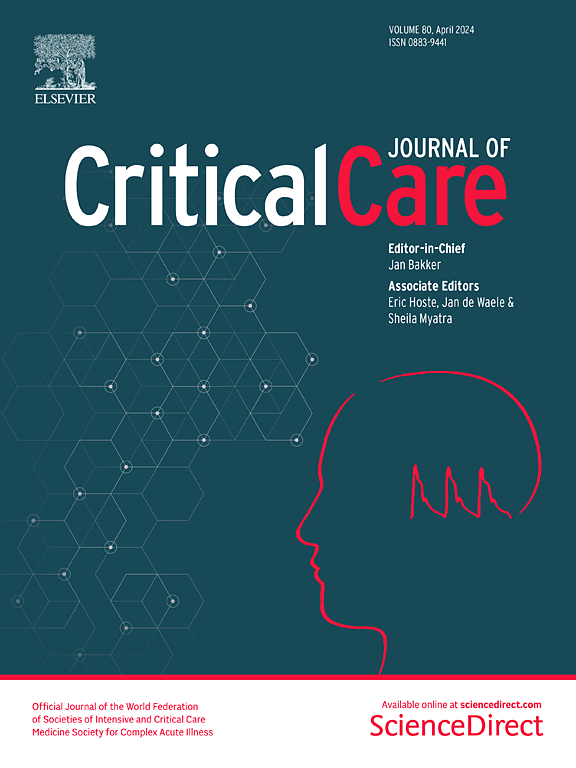Exploring the effectiveness of eHealth interventions in treating Post Intensive Care Syndrome (PICS) outcomes: a systematic review
IF 8.8
1区 医学
Q1 CRITICAL CARE MEDICINE
引用次数: 0
Abstract
It remains unclear how to optimise critical care rehabilitation to reduce the constellation of long-term physical, psychological and cognitive impairments known as Post Intensive Care Syndrome (PICS). Possible reasons for poor recovery include access to care and delayed treatment. eHealth could potentially aid in increasing access and providing consistent care remotely. Our review aimed to evaluate the effectiveness of eHealth interventions on PICS outcomes. Studies reporting eHealth interventions targeting Post Intensive Care Syndrome outcomes, published in Medline, CINAHL, PsycINFO, Embase, and Scopus from 30th January 2010 to 12th February 2024, were included in the review. Study eligibility was assessed by two reviewers with any disagreements discussed between them or resolved by a third reviewer. Study quality and risk of bias were assessed using the Mixed Method Appraisal Tool. Further to the identification of effective strategies, our review also aimed to clarify the timeline of recovery considered and the outcomes or domains targeted by the interventions. Thirteen studies were included in our review. Study duration, eHealth intervention delivery format, and outcome measures varied considerably. No studies reported a theory of behavioural change and only one study was co-produced with patients or carers. Most studies were conducted in the early post-discharge phase (i.e., < 3 months) and had feasibility as a primary outcome. The cognitive domain was the least targeted and no intervention targeted all three domains. Interventions targeting the psychological domain suggest generally positive effects. However, results were underpowered and preliminary. Though all studies were concluded to be feasible, most studies did not assess acceptability. In studies that did assess acceptability, the main facilitators of acceptability were usability and perceived usefulness, and the main barrier was sensitivity to mental health and cognitive issues. Our systematic review highlighted the promising contributions of eHealth with preliminary support for the feasibility of interventions in the early stages of post-critical care rehabilitation. Future research should focus on demonstrating effectiveness, acceptability, the cognitive domain, and multi-component interventions.探索电子保健干预措施在治疗重症监护后综合征(PICS)结果方面的有效性:系统性综述
目前仍不清楚如何优化重症监护康复,以减少被称为 "重症监护后综合征"(PICS)的长期身体、心理和认知障碍。康复效果不佳的可能原因包括获得护理的机会和治疗延迟。我们的综述旨在评估电子医疗干预对 PICS 结果的有效性。综述纳入了 2010 年 1 月 30 日至 2024 年 2 月 12 日期间在 Medline、CINAHL、PsycINFO、Embase 和 Scopus 上发表的针对重症监护后综合症疗效的电子健康干预措施的研究报告。研究资格由两名审稿人进行评估,如有分歧,则由两人讨论,或由第三名审稿人解决。研究质量和偏倚风险采用混合方法评估工具进行评估。除确定有效策略外,我们的综述还旨在明确所考虑的康复时间表以及干预措施所针对的结果或领域。我们的综述共纳入了 13 项研究。研究的持续时间、电子健康干预的实施形式和结果衡量标准差异很大。没有研究报告了行为改变理论,只有一项研究是与患者或护理人员共同完成的。大多数研究都是在出院后的早期阶段(即小于 3 个月)进行的,并将可行性作为主要结果。针对认知领域的干预最少,也没有针对所有三个领域的干预。以心理领域为目标的干预措施普遍具有积极的效果。然而,这些结果都是初步性的。虽然所有研究都被认为是可行的,但大多数研究都没有评估可接受性。在评估了可接受性的研究中,可接受性的主要促进因素是可用性和感知有用性,主要障碍是对心理健康和认知问题的敏感性。我们的系统性综述强调了电子保健的巨大贡献,并初步支持在重症监护后康复的早期阶段采取干预措施的可行性。未来的研究应侧重于证明有效性、可接受性、认知领域和多成分干预措施。
本文章由计算机程序翻译,如有差异,请以英文原文为准。
求助全文
约1分钟内获得全文
求助全文
来源期刊

Critical Care
医学-危重病医学
CiteScore
20.60
自引率
3.30%
发文量
348
审稿时长
1.5 months
期刊介绍:
Critical Care is an esteemed international medical journal that undergoes a rigorous peer-review process to maintain its high quality standards. Its primary objective is to enhance the healthcare services offered to critically ill patients. To achieve this, the journal focuses on gathering, exchanging, disseminating, and endorsing evidence-based information that is highly relevant to intensivists. By doing so, Critical Care seeks to provide a thorough and inclusive examination of the intensive care field.
 求助内容:
求助内容: 应助结果提醒方式:
应助结果提醒方式:


